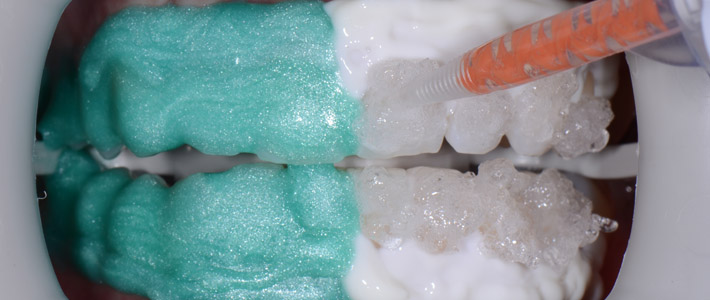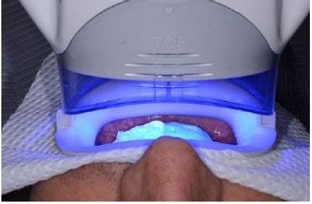By Shannon Pace Brinker, CDA, CDD
Unlike other esthetic dental treatments available today, tooth whitening has the potential to dramatically enhance the appearance of a patient’s smile in a single office visit, without invasive procedures. Ideal based on its ease of use, quick treatment time, and predictability, tooth whitening can be provided as a stand-alone procedure or as part of a restorative treatment plan. A rise in tooth whitening popularity can be attributed in part to its cost-effectiveness and immediate results. To meet tooth whitening demands, a variety of bleaching solutions and techniques have been developed, enabling shorter and more convenient treatments, more predictable results, and minimal side effects.
However, despite advancements in whitening materials and techniques, among the side effects that many patients still may experience either during or after in-office whitening are pain and/or increased sensitivity. A literature review completed by Hasson et al. showed that tooth sensitivity and oral irritation represent the most commonly reported side effects associated with tooth whitening.1 The mechanisms associated with this pain (e.g., potential pulpal involvement) and sensitivity can cause complications post-treatment and deter patients from undergoing whitening procedures.
While there are several theories to explain post-whitening pain and sensitivity, the concentration of the whitening solution and any purported whitening accelerators (e.g., light activation) may be to blame. Attempting to accelerate whitening with higher bleach concentrations and/or light (i.e., laser) activation can lead to a rise in pulpal temperatures, overly dehydrated teeth, and damage to otherwise healthy tooth structure. Although fluoride and potassium nitrate have been incorporated into whitening techniques to help minimize sensitivity, it is imperative for dental professionals to understand the full implications of light to the whitening process.
How Light Activation Impacts Tooth Dehydration and Whitening Efficacy
Teeth are porous, allowing whitening agents to penetrate the surface and brighten teeth. This characteristic also permits fluid to flow out of teeth, leading to dehydration. Tooth dehydration is a common side effect of whitening and has been shown to result in increased sensitivity and pain.2 Lasers, lights, or other heating sources—which were initially added to in-office whitening procedures to accelerate the reaction between the whitening solution and tooth stain molecules for enhanced decreased procedure time—compound the tooth dehydration process.3 Energy from such units hits the tooth at a very high intensity, causing some of the whitening agent to boil off into the air and some to infuse into the tooth.
As the light illuminates the tooth, the dark colored parts of the tooth (i.e., pulp chamber and dentin) absorb the light rather than reflect it. This absorbed light converts into heat energy,4 causing the internal temperature of the tooth to rise. This uncontrollable internal heat build-up triggers fluid in the pulp chamber and dentin to expand, flow out of the tooth through the protein matrix surrounding the enamel rods, and evaporate (i.e., dehydration). Dehydrated teeth can initially appear whiter after bleaching, but as rehydration occurs (usually within 7 days), the tooth color “rebounds” to a darker shade.5 Therefore, the observed immediate change after whitening may only be due to dehydration, rather than actual bleaching effects. This may explain why quick, in-office light-accelerated tooth whitening produces initial dramatically visible results that, over time, revert to a darker shade.
What’s more, the fluid movement out of the tooth that results from light- or laser-accelerated whitening may actually inhibit whitening agents from entering tooth structures, since this forces whitening solutions to travel against the flow. As a result, use of a light or heat source may contribute to ineffective whitening procedures. Further, activating bleaching agents with heat, light, or laser can also adversely affect pulpal tissue by increasing intra-pulpal temperature.6 This overheating, combined with tooth dehydration, contributes to the pain and sensitivity that is often reported following light-assisted whitening procedures.
Several studies in recent years have determined that lasers and lights incorporated with in-office whitening procedures do not prevent or reduce tooth sensitivity or improve the efficacy of bleaching.3,7-9 Research by Amengual et al. even found that more subjects experienced sensitivity due to light-activated whitening techniques compared to those who underwent chemically activated in-office whitening techniques.10 Thus, dental professionals must consider alternative methods to effectively whiten teeth within the practice, without the use of light-activated techniques.
Chemically Activated In-Office Whitening Solutions
With chemically activated whitening solutions, the in-office process does not require a light source of any kind. Research indicates that when using high concentration bleaching agents, bleaching with light activation offers no benefits compared to bleaching without light activation.7-9,11
Does this light work?
| We conducted evaluation of two whitening systems that were the most popular whitening offered in practices. One that required a light source and one that did not. We also wanted to see if there would be a significant difference in the shade shift and would the patient have and sensitivity during or after treatment (Fig 1). |
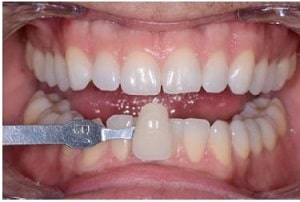
Figure 1: Preoperative Shade B1. |
Retractor and gingival barrier was placed for each manufacturer. Block out resin was applied to facial and gingival areas of the teeth that whitening on the right was not performed with the light. The patient’s left right side, in-office whitening that requires a light was placed on the facial surfaces of the teeth (Fig 2). Whitening was performed as directed by manufacturer’s instructions for a total of 4 cycles at 15 minutes each. (Fig 3).
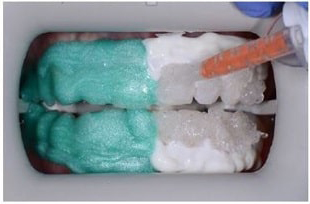
Figure 2: Pre-Operative view of the patient’s initial dentition |
Figure 3: Close up of whitening utilizing a light source
|
|
After the cycles were completed, the whitening agent was removed from the left side and the teeth were coved with gingival barrier to protect those that had already been whitened. Opalescence Boost 40% was placed on the teeth on the patient’s right side and performed as directed by manufacturer instructions for (2) 20 minute sessions for a total 40 minutes (Fig 4). Then the whitening agent was removed along with the gingival barrier (Fig 5).
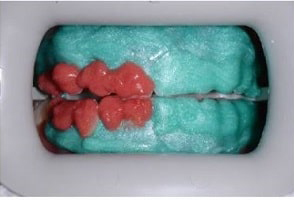
Figure 4: Whitening agent is removed from the left side and
the teeth were coved with gingival barrier. |
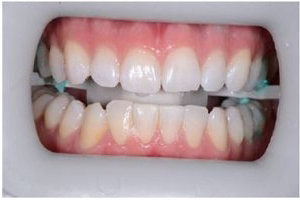
Figure 5: Whitening and gingival barrier are removed. |
|
Immediate shade comparison with Vita shade tabs (Fig 6). The teeth on the left side were slightly whiter in comparison. Patient did complain of discomfort on the teeth that the in-office whitening light was used. You can see the comparison the day of utilizing the Vita Whitening Guide with the comparison of shades close up. Three days later, the patient, who was not given any take home whitening product as a follow up to the in-office whitening, came in for a shade comparison again (Fig 7). After teeth rehydrated, patient who is a dentist, saw no real difference in post op shade.
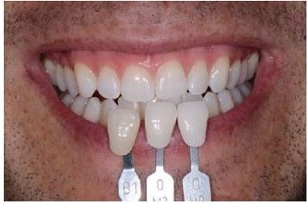
Figure 6: Immediate shade comparison with Vita shade tabs |
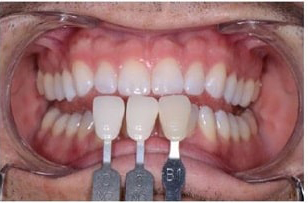
Figure 7: Three day post-op shade comparison |
|
Conclusion
Although light-activation of whitening agents has existed for some time, research has demonstrated its ineffectiveness to enhance bleaching efficacy. Additionally, the science behind light activated whitening may explain why many patients experience pain after this type of whitening treatment. As a result of internally heating a tooth, dehydration as well as damage to healthy tooth structure can occur, increasing the likelihood of sensitivity and pain both during and after the whitening treatment. Chemically activated in-office whitening, on the other hand, does not require a light source for efficient and effective whitening.
References
-
Hasson H, Ismail A, Neiva G. Home-based chemically-induced whitening of teeth in adults. Cochrane Database Syst Rev. 2006 Oct;18(4):CD006202.
-
Kugel G, Ferreira S. The art and science of tooth whitening. J Mass Dent Soc. 2005 Winter;53(4):34-7.
-
de Almeida Farhat PB, Santos FA, Gomes JC, Gomes OM. Evaluation of the efficacy of LED-laser treatment and control of tooth sensitivity during in-office bleaching procedures. Photomed Laser Surg. 2014 Jul;32(7):422-6.
-
Torres CR, Souza CS, Borges AB, Huhtala MF, Caneppele TMF. Influence of concentration and activation on hydrogen peroxide diffusion through dental tissues in vitro. ScientificWorldJournal. 2013 Sep 18;2013:193241.
-
Kugel G, Ferreira S, Sharma S, Barker ML, Gerlach RW. Clinical trial assessing light enhancement of in-office whitening. J Esthet Restor Dent. 2009;21(5):336-47.
-
Buchalla W, Attin T. External bleaching therapy with activation by heat light or laser-a systematic review. Dent Mater. 2007 May;23(5):586-96.
-
He LB, Shao MY, Tan K, Xu X, Li JY. The effects of light on bleaching and tooth sensitivity during in-office vital bleaching: a systematic review and meta-analysis. J Dent. 2012 Aug;40(8):644-53.
-
Lima DA, Aguiar FH, Liporoni PC, Munin E, Ambrosano GM, Lovadino JR. Influence of chemical or physical catalysts on high concentration bleaching agents. Eur J Esthet Dent. 2011 Winter;6(4):454-66.
-
Kugel G, Papathanasiou A, Williams AJ 3rd, Anderson C, Ferreira S. Clinical evaluation of chemical and light-activated tooth whitening systems. Compend Contin Educ Dent. 2006 Jan;27(1):54-62.
-
Amengual J, Forner L. Dentine hypersensitivity in dental bleaching: case report. Minerva Stomatol. 2009 Apr;58(4):181-5.
